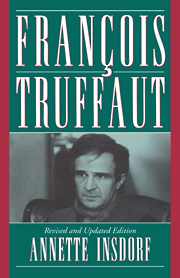Book contents
1 - From “Cinéphile” to “Cinéaste”
Summary
IMAGINE (or if you are lucky, remember) the thrill of being a child at the movies—especially if you manage to sneak in, and especially if you are playing hooky. François Truffaut's critical writings and films suggest that he has never forgotten the shivers of delight inherent in the early movie-watching experience: the escape into darkness and surprises, the screen that overwhelms with people larger than life, and then the growing realization that film is less a substitute for life than a frame for a more intense and moving picture of it.
Truffaut's early film-going experiences were flavored by what we might call “sinema”: not only were his excursions into the darkness clandestine, but they were accompanied by a growing awareness of sexuality. A fine example of this conjunction in the boy's mind (around the age of twelve) is his recollection of lost panties in the 4,500-seat Gaumont-Palace in Paris during the Occupation. He learned from his friend—whose mother worked at the famous movie theater—that after the last show every Sunday night, at least sixty pairs of panties would be found under the seats: “I hardly need to add that these sixty little weekly panties—we never failed to check the exact number … —made us dream in a direction that had little to do with the art of cinema or the ideas of Bazin.”
Nevertheless, Truffaut's first films prove that the kind of experience he recalls here has everything to do with filmic art.
- Type
- Chapter
- Information
- François Truffaut , pp. 15 - 38Publisher: Cambridge University PressPrint publication year: 1995

